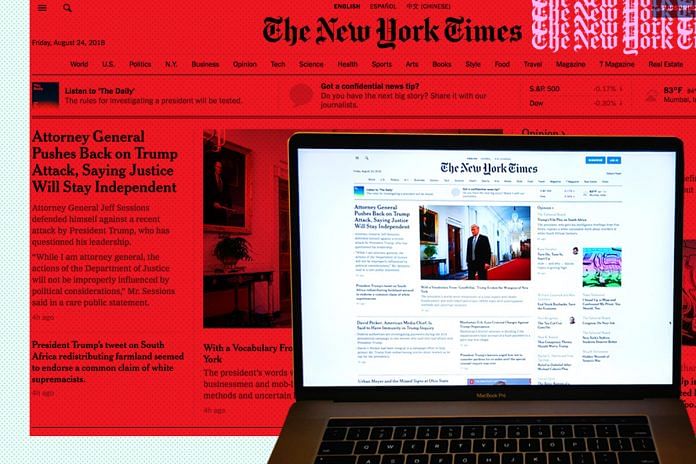The New York Times has decided to remove bylines for reports from its website homepage.
Although executive editor, Dean Baquet, and managing editor, Joe Kahn, said the decision has been taken keeping website design in mind, the move has triggered widespread outrage across social media.
ThePrint asks – By killing bylines, is NYT putting readers first or needlessly hurting reporter egos?
Bylines provide credibility, removing them makes no sense
 Chandan Mitra
Chandan Mitra
Editor-in-Chief and Managing Director, The Pioneer
The New York Times‘ decision to remove bylines from their homepage is not a particularly sound decision. There are two reasons for this. First, bylines provide credibility to news reports. In their absence, it would seem the story has a particular angle. It may be perceived that the story has been put out by the ownership, or the management of the media house. A crucial sense of responsibility goes missing with the disappearing names.
Second, there are some stories that are better written than others. Often readers gravitate back to these reporters because they enjoyed reading the piece. If anything, contrary to the editors’ claim, the removal of bylines will make it harder for the reader to distinguish between the stories they actually wanted to read and the ones they don’t.
Unlike The Economist that has an upfront editorial policy that only one byline is given through the entire career, The New York Times has changed its stance out of the blue. I don’t see what purpose this serves.
Journalists invest time and effort in their stories. A byline is their due credit. This only comes across a bad idea. I’m not much of a reader of digital media, but I sincerely hope that it won’t happen in the print version.
Bylines end up exposing good journalists to physical, virtual and legal attacks
 Krishna Prasad
Krishna Prasad
Former editor-in-chief, Outlook
The move by NYT to do away with bylines may go against the zeitgeist, but ‘panna pramukhs’ in Indian media houses may like to consider some of its merits in the prevailing media atmosphere. The Economist, written by a bunch of Oxford grads, has a no-byline policy. Can anyone argue that it is poorer read because of that? In fact, you could contend that its anonymity heightens its credibility and the reading experience. Up to a point.
In India, especially in these polarised times, the moment you see a byline you know what a piece will say, or whose cause is being advanced by a newspaper or website. A judicious use of bylines, a half-way house between NYT and The Economist, will help restore balance and sobriety, while giving journalists and organisations the freedom to speak their mind. A plethora of bylines robs the reader of the essential requirements of good journalism: surprise and suspense.
Sure, a blanket ban will hurt narcissistic, image-conscious journalists between their ears, depriving them of the reward and recognition that their identity gives, which they actively seek. But partial anonymity might help enhance the seriousness of daily print journalism. In any case, bylines are a more recent post-magazine phenomenon in Indian media like in the rest of the world. For the longest time, The Hindu and other top Indian newspapers like The Statesman did not have bylines except that of their Delhi bureau chief. Except giving an inflated sense of ownership for the writer, what do bylines do for the reader?
In an age of shrinking media freedoms, bylines end up exposing good journalists to physical, virtual and legal attacks from state and non-state actors, bots and trolls. Today, reporters claim bylines even for covering press conferences or rehashing press releases. What is exclusive about that? On TV, even the most mundane reports also carry a byline– not only for the reporter but also for the cameraperson. We need to make journalists earn their spurs rather than handing it to them on a platter. We need to make journalism less of an ego trip.
Issue of NYT removing bylines from homepage is overblown
 Annie Gowen
Annie Gowen
India Bureau Chief, The Washington Post
I feel the controversy surrounding The New York Times taking down bylines on its homepage has been overblown and fuelled by silly outrage on social media. Politico even headlined its story “Does the New York Times Hate its Reporters?” Answer: No.
Frankly, it’s a little ridiculous. There are so many other pressing issues in the world to discuss than this non-controversy.
Yes, bylines are important. They acquaint readers with the reporter’s body of work. They provide context. Often, people who have engaged with the reporter’s work before may want to come back and read more of what they have written. And they will remain atop The New York Times stories.
I think bylines should be displayed on the homepage. I would have preferred it that way.
But the truth of the matter is that newspaper homepages are not a big driver of traffic any more, mobiles are far more important. And as The Times’ Executive Editor Dean Baquet and Managing Editor Joe Kahn rightly said in a note to readers about the matter on 22 August: “Bylines have not been displayed above summaries on the mobile web or in our mobile apps, where more readers view our journalism than on desktop computers, for quite some time”.
Also read: Karan Thapar broke the cardinal rule of journalism and is too entitled to admit it
Reporters’ egos can be fragile and fickle, but most will eventually accept byline removal
 Soutik Biswas
Soutik Biswas
India Correspondent and Features Editor, BBC News
Bylines are a mixed blessing.
On the one hand, they have lost some of their distinction after newspapers began attaching them to almost every news story beyond a certain length. There are so many bylines on indifferent stories these days that readers don’t care about who wrote the story any longer.
Richard Harwood, the great Washington Post journalist, once said bylines essentially satisfy “reportorial egos and impress moms, dads and our fourth-grade teachers”.
On the other hand, bylines in publications like the The New York Times, The Washington Post or The New Yorker possibly matter more. With their newsrooms stacked with brilliant journalists, many readers would definitely associate bylines with high quality, well-written journalism and want to find their favourite writers easily.
Pamela Colloff, one of the bylines I search for and read, believes many readers click on a story on the NYT homepage just because of the byline. “A byline”, she tweeted, “is more than just a name: it speaks to an entire body of work, and to the breadth and depth of a reporter’s knowledge.” I’d imagine the vast majority of readers gravitate to what looks like a compelling story first, and then discover the writers later.
So, yes, bylines do matter. But look at The Economist, one of the world’s most respected and widely read publications, and a shining exception. The magazine continues to prove that you can be respected and have enough have heft and influence with anonymous reportage and analysis.
By doing away with bylines on the homepage, NYT’s editors and designers are trying to make the homepage clutter free and dynamic. Nothing wrong with that. If you observe closely, the bylines on their story pages have actually become more prominent than what they used to be.
Reporters’ egos can be fragile and fickle. I think most of them will come around and accept this change, and readers will continue to click on stories that interest them, and find out often that they have been written by their favourite reporters.
Bylines a small price to pay if NYT wants to improve reader experience
 Milind Khandekar
Milind Khandekar
Former managing editor, ABP News
The New York Times is just doing away with the bylines from their homepage and not from the actual stories. They are right in prioritising readers’ experience over bylines appearing on the homepage.
Back in the good old days, journalists would hardly get a byline for every story they did. When I started off as a journalist, I remember getting bylines only for exclusive stories —never for the regular ones. I have done several reports that were published without my name on it. I am not sure about the US media, but bylines are relatively recent phenomena in Indian media.
While I am glad and appreciative of the fact that readers are getting to know who the reporter is, we shouldn’t make a big deal out of NYT doing away with the bylines on their website. It is a small and rather inconsequential thing that reporters won’t see their bylines in the homepage. If NYT editors feel removing the bylines would add to reader experience, then this is a small price to pay.
Compiled by Deeksha Bhardwaj and Fatima Khan, journalists at ThePrint.



